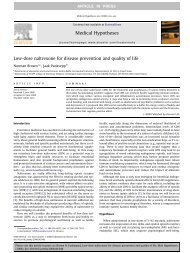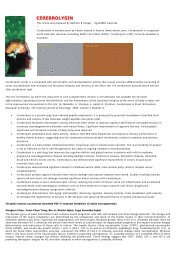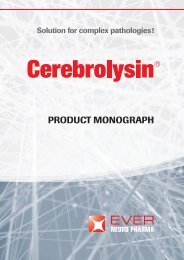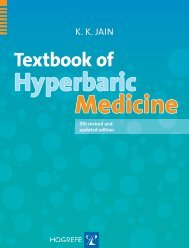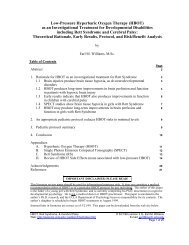The Relevance of Hyperbaric Oxygen to Combat Medicine
The Relevance of Hyperbaric Oxygen to Combat Medicine
The Relevance of Hyperbaric Oxygen to Combat Medicine
Create successful ePaper yourself
Turn your PDF publications into a flip-book with our unique Google optimized e-Paper software.
UNCLASSIFIEDDefense Technical Information CenterCompilation Part NoticeADPO 11081TITLE: <strong>The</strong> <strong>Relevance</strong> <strong>of</strong> <strong>Hyperbaric</strong> <strong>Oxygen</strong> <strong>to</strong> <strong>Combat</strong> <strong>Medicine</strong>DISTRIBUTION: Approved for public release, distribution unlimitedThis paper is part <strong>of</strong> the following report:TITLE: Operational Medical Issues in Hypo-and <strong>Hyperbaric</strong> Conditions[les Questions medicales a caractere oprationel liees aux conditionshypobares ou hyperbares]To order the complete compilation report, use: ADA395680<strong>The</strong> component part is provided here <strong>to</strong> allow users access <strong>to</strong> individually authored sectionsf proceedings, annals, symposia, etc. However, the component should be considered within[he context <strong>of</strong> the overall compilation report and not as a stand-alone technical report.<strong>The</strong> following component part numbers comprise the compilation report:ADPO11059 thru ADP011100UNCLASSIFIED
25-1<strong>The</strong> <strong>Relevance</strong> <strong>of</strong> <strong>Hyperbaric</strong> <strong>Oxygen</strong> <strong>to</strong> <strong>Combat</strong> <strong>Medicine</strong>James K. Wright, Col, MC, FSUSAF School <strong>of</strong> Aerospace <strong>Medicine</strong>/FEH2602, West Gate Road - Brooks AFB, TX 78235-5252, USAAt the Davis <strong>Hyperbaric</strong> Labora<strong>to</strong>ry, Brooks AFB, TX we have embarked on a series <strong>of</strong> research pro<strong>to</strong>colsdesigned <strong>to</strong> determine the efficacy <strong>of</strong> hyperbaric oxygen treatment (HBO) in combat wounds. Our research hasbeen directed <strong>to</strong>wards finding ways <strong>to</strong> minimize the extent <strong>of</strong> combat injury, reduce the consumption <strong>of</strong> medicalresources, speed healing <strong>of</strong> combat wounds, and improve the result in the healed wound. In this presentation thebasic science related <strong>to</strong> the use <strong>of</strong> HBO in treating combat wounds will be presented and our current researchefforts will be discussed.Actions <strong>of</strong> HBOSeveral <strong>of</strong> the cellular and molecular actions <strong>of</strong> HBO make it an attractive adjunct <strong>to</strong> combat wound treatment.<strong>Hyperbaric</strong> oxygen therapy has been shown <strong>to</strong> expedite wound healing by hastening angiogenesis, increasing orres<strong>to</strong>ring the bactericidal properties <strong>of</strong> polymorphonuclear lymphocytes and macrophages, speeding themigration <strong>of</strong> macrophages, and hastening wound epithelialization and contraction 1 ' 2 ,'3. <strong>The</strong>se effects have beenclinically useful and proven for diabetic wounds, poorly vascularized tissue, infected tissue, osteomyelitis, andirradiated tissue 4 ' 5 . In full thickness, skin grafts and flaps, hyperbaric oxygen has been shown <strong>to</strong> speed healingand enhance flap take and graft survival, especially when compromised 6 ' 7 ' ' 9 ' 1 °' 11 . In burn patients undergoinggrafting procedures, hyperbaric oxygen has been shown <strong>to</strong> shorten hospital stay, enhance donor site and grafthealing, and reduce the number <strong>of</strong> grafting procedures required for wound closure12"13" 4 . <strong>The</strong> salvaging effect <strong>of</strong>hyperbaric oxygen on failing flaps and full thickness skin grafts has been demonstrated in numerousst e d 15,16,17.studies' 5 1 "' Tibbles, P. M., and Edelsberg, J. S. <strong>Hyperbaric</strong> <strong>Oxygen</strong> <strong>The</strong>rapy. N Eng Jmed 334: 1642-1648, 1996.2 Kindwall, E. P., Gottlieb, L. J., and Larson, D. L. <strong>Hyperbaric</strong> oxygen therapy in plastic surgery: a review article. PlastReconstr Surg 88:898-908, 1991.3 Thorn, S.R., Mendiguren, I., Hardy, K., Bolotin, T., et al. Inhibition <strong>of</strong> human netrophil D 2 -integrin-dependent adherenceby hyperbaric 02. Am J Physiol 272 (Cell Physiol 41): C770-C777, 19974 Tibbles, 19965 Kindwall, 19916 Perrins, D. J. D. Influence <strong>of</strong> hyperbaric oxygen on the survival <strong>of</strong> split skin grafts, Lancet 1967 Apr 22: 868-87 1.7 McFarlane, R. M., Wermuth, R. E., <strong>The</strong> use <strong>of</strong> hyperbaric oxygen <strong>to</strong> prevent necrosis in experimental pedicleflaps andcomposite skin grafts. Plast Reconstr Surg 37:422-430, 1966.8 Gruber, R. P., Brinkley, F. B., Ama<strong>to</strong>, J. J., and Mendelson, J. A. <strong>Hyperbaric</strong> oxygen and pedicle flaps, skin grafts, andburns. Plast. Reconstr. Surg. 45: 24-30, 19709 Shulman, A. G., and Krohn, H. L. Influence <strong>of</strong> hyperbaric oxygen and multiple skin allografis on the healing <strong>of</strong> skinwounds. Surgery 62: 1051-1058, 1967.10 Bowersox, J. C., Strauss, M. B., and Hart, G. B. Clinical experience with hyperbaric oxygen therapy in the salvage <strong>of</strong>ischemic skin flaps and grafts. Jour Hyperbar Med 1: 141-149, 1986."1 Jurell, G., and Kaijser, L. <strong>The</strong> influence <strong>of</strong> varying pressure and duration <strong>of</strong> treatment with hyperbaric oxygen on thesurvival <strong>of</strong> skin flaps. Scand J Plast Reconstr Surg 7: 25-28, 1973."12 Cianci, P., Williams, C., Lee, H.,Shapiro, R., et al. Adjunctive hyperbaric oxygen in the treatment <strong>of</strong> thermal burns. Aneconomic analysis. J Burn Care Rehab 11: 140-143, 1990.13 Grossman, A. R. <strong>Hyperbaric</strong> oxygen in the treatment <strong>of</strong> burns. Ann Plast Surg 1: 163-171, 1978.14 Nylander, G., Nordstrom, H., and Eriksson, E. Effects <strong>of</strong> hyperbaric oxygen on oedema formation after a scald burn.Burns 10: 193-196, 1984.15 Tibbles, 1996.16 Kindwall, 1991.17 Rubin, J.S., Marzella, L., Myers, R. A., Suter, C., et al. Effect <strong>of</strong> hyperbaric oxygen on the take <strong>of</strong> composite skin grafts inrabbit ears. J Hyperbar Med 3: 79-88, 1988.Paper presented at the RTO HFM Symposium on "Operational Medical Issues in Hypo- and <strong>Hyperbaric</strong>Conditions ", held in Toron<strong>to</strong>, Canada, 16-19 Oc<strong>to</strong>ber 2000, and published in RTO MP-062.
25-2HBO is capable <strong>of</strong> favorably influencing a number <strong>of</strong> cy<strong>to</strong>kines and growth fac<strong>to</strong>rs integral <strong>to</strong> wound healing.When administered after wounding, HBO up-regulates collagen synthesis through pro-al (I) mRNAexpression 1 8 . In rabbit ear wounds HBO has been shown <strong>to</strong> up-regulate mRNA for the PDGFP3 recep<strong>to</strong>r 1 9 . Thiseffect has been further born out in clinical studies. In ischemic flaps HBO up-regulates fibroblast growth fac<strong>to</strong>r(FGF) causing an increased effect over that seen with fibroblast growth fac<strong>to</strong>r alone 20 . In situations where FGFis ineffective, HBO can render it highly effective 21 . This is an effect different than up-regulation. In patientswith Crohn's disease IL-1, IL-6, and TNFx. levels were diminished during HBO treatment22. TNF levels innormal rats became elevated after a single exposure <strong>to</strong> HB0 23 . Perhaps under different physiologic conditionsHBO may cause up or down regulation <strong>of</strong> cy<strong>to</strong>kines. Vascular endothelial growth fac<strong>to</strong>r (VEGF) is upregulatedby hypoxia, yet HBO also up-regulates this fac<strong>to</strong>r 24 . Transforming growth fac<strong>to</strong>r-P3 (TGF-P31) andplatelet-derived growth fac<strong>to</strong>r PP3 (PDGF-P3) are synergistically enhanced by HB0 25 .<strong>The</strong> HBO paradox: up-regulation <strong>of</strong> events stimulated by hypoxia:HBO thus acts in a paradoxical manner. Many <strong>of</strong> the processes that are stimulated by hypoxia are acceleratedby the administration <strong>of</strong> HBO. <strong>The</strong> following biologic processes and fac<strong>to</strong>rs are stimulated or up-regulated byhypoxia, and by HBO: angiogenesis, collagen synthesis, and osteoclastic activity. One known mechanism is thatby which fibroblasts are stimulated <strong>to</strong> make collagen through peroxides, which occur, in the hypoxic wound andduring HBO treatment 26 . <strong>The</strong>refore the peroxides generated by HBO mimic one <strong>of</strong> the stimuli found in hypoxia.Another mechanism is the stimulation <strong>of</strong> cy<strong>to</strong>kines by hypoxia and further upregulation <strong>of</strong> these cy<strong>to</strong>kines underthe hyperoxia, which occurs during HBO treatment. This is the case for some interleukines and for tumornecrosis fac<strong>to</strong>r (TNF). <strong>The</strong>re is some confusion on the exact timing <strong>of</strong> the release <strong>of</strong> growth fac<strong>to</strong>rs andcy<strong>to</strong>kines; in one study VEGF, TNF-u., and TGF-P3 occurred in hypoxic wounds after they had been released innormoxia. VEGF, TGF-P3, and PDGF-P3 have bi-phasic release patterns; their release is stimulated by hypoxiaand hyperoxia, but is lowest during normoxia27,28. Furthermore, the activity <strong>of</strong> released VEGF is further29enhanced during hyperoxia, especially in the presence <strong>of</strong> lactate . It is clear that biologically active chemicalssuch as cy<strong>to</strong>kines and growth fac<strong>to</strong>rs have a complex array <strong>of</strong> stimuli <strong>to</strong> up and down regulate activity. <strong>Oxygen</strong>,cy<strong>to</strong>kines, and biologically active chemicals and metals appear <strong>to</strong> have key roles in the expression <strong>of</strong> healing.As we learn more about the role <strong>of</strong> oxygen its role appears <strong>to</strong> be much more detailed than in a simple massactionequation."18 Ishii, Y., Myanaga, Y., Shimojo, H., Ushida, T., and Tateishi, T. Effects <strong>of</strong> hyperbaric oxygen on procollagen messengerRNA levels and collagen synthesis in the healing <strong>of</strong> rat tendon laceration. Tissue Eng 5: 279-86, 1999.19 Bonomo, S. R., Davidson, J. D., Yu, Y., Xia, Y. et al. <strong>Hyperbaric</strong> oxygen as a signal transducer: upregulation <strong>of</strong>plateletderived growth fac<strong>to</strong>r-beta recep<strong>to</strong>r in the presence <strong>of</strong> HB02 and PDGF. Undersea Hyperb Med 25: 211-6, 1998.20 Bayati, S., Russell, R. C., and Roth, A. C. Stimulation <strong>of</strong> angiogenesis <strong>to</strong> improve the viability <strong>of</strong>prefabricated flaps.Plast Reconstr Surg 101: 1290-5, 1998.21 Wu, L., Pierce, G. F., Ladin, D. A., Zhao, L. L., et al. Effects <strong>of</strong> oxygen on wound responses <strong>to</strong> growth fac<strong>to</strong>rs: Kaposi'sFGF, but not basic FGF stimulates repair in ischemic wounds. Growth Fac<strong>to</strong>rs 12: 29-35, 1995.22 Weisz, G., Lavy, A., Adir, Y., Melamed, Y., et al. Modification <strong>of</strong> in vivo and in vitro TNF-alpha, IL-1, and IL-6secretion by circulating monocytes during hyperbaric oxygen treatment in patients with perianal Crohn's disease. J ClinImmunol 17: 154-9, 1997.23 Lahat, N., Bitterman, H., Yaniv, N., Kinarty, A., and Bitterman, N. Exposure <strong>to</strong> hyperbaric oxygen induces tumornecrosis fac<strong>to</strong>r alpha (TNF-alpha) secretion from rat macrophages. Clin Exp Immunol 102: 655-9, 1995.24 Hunt, T. K. <strong>Oxygen</strong> and wound healing. <strong>Hyperbaric</strong> <strong>Medicine</strong> 2000, 8th Annual Advanced Symposium, Columbia, S. C.14-15 April 200025 Zhao, L. L., Davidson, J. D., Wee, S. C., Roth, S. I., and Mus<strong>to</strong>e, T. A. Effect <strong>of</strong> hyperbaric oxygen and growth fac<strong>to</strong>rson rabbit ear ischemic ulcers. Arch Surg 129: 1043-9, 1994.26 ibid.27 Haroon, Z. A., Raleigh, J. A., Greenburg, C. S., and Dewhirst, M. W. Early wound healing exhibits cy<strong>to</strong>kine surgewithout evidence <strong>of</strong> hypoxia. Ann Surg 231: 137-147, 2000.28 Gleadle, J. M., and Ratcliffe, P. J. Hypoxia and the regulation <strong>of</strong> gene expression. Mol Med Today 4: 122-9, 1998.29 Haroon, 2000.
25-3In reperfusion injury, HBO diminishes tissue damage caused by leukocyte activation. In muscle this effect <strong>of</strong>HBO is mediated by inhibiting synthesis <strong>of</strong> guanylate cyclase (cGMP) and subsequent leukocyte P3-2 integrindependent adhesion3 This adhesion <strong>of</strong> leukocytes <strong>to</strong> vessel walls initiates the reperfusion injuryinflamma<strong>to</strong>ry cascade 32 ' 33 . In cardiac muscle the action <strong>of</strong> leukocytes is thought <strong>to</strong> be largely responsible for thereperfusion injury <strong>of</strong> myocardial infarction 3 4 . When the activation <strong>of</strong> leukocytes is blocked, they do not adhere<strong>to</strong> the P3-2 integrin recep<strong>to</strong>r on the surface <strong>of</strong> vascular endothelium and reperfusion injury is prevented 35 ' 36 .HBO acts <strong>to</strong> prevent this activation and adhesion 37 .In addition <strong>to</strong> the above mechanisms the primary reason for administration <strong>of</strong> HBO is the oxygenation <strong>of</strong> poorlyvascularized tissue - a situation present in at least a small way in nearly every wound. In addition <strong>to</strong> theprovision <strong>of</strong> tissue oxygenation levels many times the normal level, oxygen is a potent vasoconstric<strong>to</strong>r and iscapable <strong>of</strong> reducing the edema in injured tissue, facilitating blood flow and further oxygenation.Uses <strong>of</strong> HBO for combat woundsWith these cellular and molecular effects in mind we have been looking at ways <strong>of</strong> applying HBO <strong>to</strong> the clinicalsituations encountered in combat. We developed a rat skin graft - open wound model which allowed us <strong>to</strong> testthe effectiveness <strong>of</strong> HBO in treating open wounds which had been partially covered with mesh grafts. We sawno difference other than a slight increase in granulation tissue in the HBO treated group at one week, probablydue <strong>to</strong> technical problems with the model and the short time period <strong>to</strong> evaluation.We have hypothesized that HBO will shorten the time <strong>to</strong> healing <strong>of</strong> split thickness skin grafts by increasing thetensile strength <strong>of</strong> these grafts. This would allow for earlier mobilization and discharge <strong>of</strong> grafted patients. Inthe pig model we have developed we will also be able <strong>to</strong> test a number <strong>of</strong> treatments for open wounds designed<strong>to</strong> shorten epithelialization times.30 Wyatt, T. A., Lincoln, T. M., and Pryzwansky, K. B. Regulation <strong>of</strong> neutrophil degranulation by LY-83583 and L-arginine: role <strong>of</strong> cGMP-dependent protein kinase. Am J. Physiol 265: C201-211, 1993.31 Thom, S. R., Mendiguren, I., Hardy, K., Bolotin, T. et al. Inhibition <strong>of</strong> human neutrophil P-2 integrin-dependentadherence by hyperbaric 02. Am J Physiol 272: C770-C777, 1997.32 Maxwell, S. R. J., and Lip, G. Y. H. Reperfusion injury: a review <strong>of</strong> the pathophysiology, clinical manifestations andtherapeutic options. Int J Cardiol 58: 95-117, 1997.33 Virkhaus, R. Lucchesi, B. R., Simpson, P.J., and Shebuski, R. J. <strong>The</strong> role <strong>of</strong> adhesion molecules in cardiovascularpharmacology: Meeting review. J Pharm Exp <strong>The</strong>r 273: 569-565, 1995.34 Jordan, J. E., Zhao, Z-Q, and Vinten-Johansen, J. <strong>The</strong> role <strong>of</strong> neutrophils in myocardial ischemia-reperfusion injury.Cardiovasc Res 43: 860-878, 1999.35 Thomas, M. P., Brown, L. A., Sponseller, D. R., Williamson, S. E. et al. Myocardial infarct size reduction by thesynergistic effect <strong>of</strong> hyperbaric oxygen and recombinant tissue plasminogen activa<strong>to</strong>r. Am Heart J 120: 791-800, 1990.36 Dolan, R., Hartshorn, K., Andry, C., Tablante, J., et al. In vivo correlation <strong>of</strong> neutrophil recep<strong>to</strong>r expression, ischemiareperfusioninjury, and selective 5-lipoxygenase inhibition in guinea pigs. Arch O<strong>to</strong>laryngol Head Neck Surg 124:1377-1380, 1998.31 Zamboni, W. A., Wong, H. P., and Stephenson, L. L. Effect <strong>of</strong> hyperbaric oxygen on neutrophil concentration andpulmonary sequestration in reperfusion injury. Arch Surg 131: 736-760, 1996.
25-4Tensile Strength <strong>of</strong> SplitThickness Skin Grafts in the Pig700600500400C14E30020010000.04 0.08 0.12 0.17 0.25 1 2 3 7Time post Op (days)We have begun two pro<strong>to</strong>cols testing the effect <strong>of</strong> HBO on the healing <strong>of</strong> fractures in long bones. In our clinicalpro<strong>to</strong>col we are testing the effect <strong>of</strong> HBO on the time <strong>to</strong> fracture healing in patients with lower extremityfractures. It is <strong>to</strong>o early <strong>to</strong> assess results but we are hypothesizing that we will see a 20% reduction in healingtime with a lessened need for secondary procedures and a lower complication rate in the HBO treated group. Ina rabbit study we are testing the tensile strength <strong>of</strong> the rabbit tibia after osteo<strong>to</strong>my and compression platefixation in control and HBO treated groups.We have postulated that HBO will reduce the recovery time in nerve injuries and possibly improve the endresult based on animal studies showing that nerves subjected <strong>to</strong> division, ischemia, and crush injury recoverfaster when treated with hyperbaric oxygen, axonal growth is stimulated, and the end result <strong>of</strong> nerve injury issuperior <strong>to</strong> those animals not treated with HBO 38 ' 39 ' 40 ' 41 . We have developed a post radical prostatec<strong>to</strong>mypro<strong>to</strong>col investigating the incidence and rate <strong>of</strong> recovery <strong>of</strong> impotence following the procedure in HBO andcontrol groups. In addition we have carpal tunnel syndrome and nerve laceration pro<strong>to</strong>cols under consideration.In our facility we see a large number <strong>of</strong> chronic open wounds from a variety <strong>of</strong> causes - diabetes, peripheralvascular disease, and radiation are the major contribu<strong>to</strong>rs. HBO has a role in accelerating the healing <strong>of</strong> thesewounds, but we have very little knowledge on the interplay <strong>of</strong> cellular and biochemical events in wound healingand how these are affected by HBO. We have designed a human study and two rodent studies <strong>to</strong> evaluate therole <strong>of</strong> growth fac<strong>to</strong>rs and biomarkers in wound healing and their ability <strong>to</strong> predict a favorable result. In ourhuman work we have found that individual patients have slow and fast healing phases, sometimes alternating,and that the appearance <strong>of</strong> nitric oxide by products in the urine is a reliable predic<strong>to</strong>r <strong>of</strong> wound closure." Haapeniemi, T., Nylander, G., Kanje, M., and Dahlin, L. <strong>Hyperbaric</strong> oxygen enhances regeneration <strong>of</strong> the rat sciaticnerve. Exp Neurol 149: 433-8, 1998.39 Bradshaw, P.O., Nelson, A.G., Fan<strong>to</strong>n, J.W., Yates, T., et al. Effect <strong>of</strong> hyperbaric oxygenation on peripheral nerveregeneration in adult male rabbits. Undersea Hyperb Med 23: 107-13, 1996.40 Tibbles, P. M., and Edelsberg, J. S. <strong>Hyperbaric</strong>-oxygen therapy. N Eng J Med 334: 1642-1648, 1996.41 Mukoyama, M., Iida, M., and Sobue, I. <strong>Hyperbaric</strong> oxygen therapy for peripheral nerve damage induced in rabbits withclioquinol. Exp Neurol 47: 371-80, 1975.
25-5HBO has long been known <strong>to</strong> favorably affect the result <strong>of</strong> muscular compartment syndrome, lessening thedegree <strong>of</strong> muscle necrosis and even eliminating the need for fascio<strong>to</strong>my 42 ' 43 ' 44 ' 45 . We have proposed a rabbitcompartment syndrome study evaluating biomarkers <strong>of</strong> compartment syndrome, the effect <strong>of</strong> HBO inoxygenating ischemic muscle, and the end result <strong>of</strong> HBO treated animals with compartment syndrome. Wehope that the judicious and prompt use <strong>of</strong> HBO following injury may eliminate the need for surgery in somecases and improve surgical results.HBO can be lifesaving in extreme blood loss where resuscitation with blood products is not possible. We havewondered if HBO could be useful in less severe blood loss, perhaps eliminating or reducing the need for bloodtransfusion. <strong>The</strong> reduction <strong>of</strong> blood use in the field has particular appeal because <strong>of</strong> the logistical problems insupplying blood <strong>to</strong> a forward location and the ability <strong>to</strong> avoid contaminated blood. We have designed a rabbitstudy in which animals with a 50% blood loss are given HBO <strong>to</strong> determine if the recovery from blood loss isaccelerated over the control group.It is our hope that in time we will be able <strong>to</strong> position hyperbaric chambers in the forward medical facility andreduce the severity <strong>of</strong> wounds, hasten healing times, reduce the need for blood and surgical procedures, andlessen complication rates. Our current work is directed <strong>to</strong> understanding the events in injury and wound healingand identifying the parameters where HBO may be <strong>of</strong> use.42 Strauss, M. B., Hargens, A. R., Gershuni, D. H., Greenburg, D. A., et al. Reduction <strong>of</strong> skeletal muscle necrosis usingintermittent hyperbaric oxygen in a model compartment syndrome. J Bone Joint Surg 65-A: 656-662, 1983.43 Buachour, G., Cronier, P., Gouello, J. P. Toulemonde, J. L. et al. <strong>Hyperbaric</strong> oxygen therapy in the management <strong>of</strong> crushinjuries: a randomized double-blind placebo-controlled clinical trial. J. Trauma 41: 333-339, 1996.44 Mathieu, D., Wattel, F., Bouachour, G., Billard, V., and Defoin, J. F. Post-traumatic limb ischemia: prediction <strong>of</strong> finaloutcome by transcutaneous oxygen measurements in hyperbaric oxygen. J. Trauma 30: 307-314, 1990.45 Skyhar, M. J., Hargens, A. R., Strauss, M. B., Gershuni, M. D., et al. <strong>Hyperbaric</strong> oxygen reduces edema and necrosis <strong>of</strong>skeletal muscle in compartment syndromes associated with hemorrhagic hypotension. J. Bone Joint Surg 68-A: 1218-1224,1986.
This page has been deliberately left blankPage intentionnellement blanche



